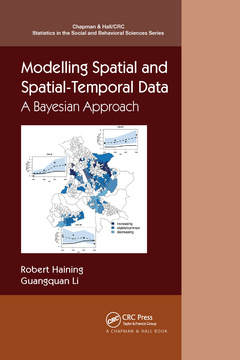Modelling Spatial and Spatial-Temporal Data: A Bayesian Approach A Bayesian Approach Chapman & Hall/CRC Statistics in the Social and Behavioral Sciences Series
Auteurs : Haining Robert P., Li Guangquan

Modelling Spatial and Spatial-Temporal Data: A Bayesian Approach is aimed at statisticians and quantitative social, economic and public health students and researchers who work with small-area spatial and spatial-temporal data. It assumes a grounding in statistical theory up to the standard linear regression model. The book compares both hierarchical and spatial econometric modelling, providing both a reference and a teaching text with exercises in each chapter. The book provides a fully Bayesian, self-contained, treatment of the underlying statistical theory, with chapters dedicated to substantive applications. The book includes WinBUGS code and R code and all datasets are available online.
Part I covers fundamental issues arising when modelling spatial and spatial-temporal data. Part II focuses on modelling cross-sectional spatial data and begins by describing exploratory methods that help guide the modelling process. There are then two theoretical chapters on Bayesian models and a chapter of applications. Two chapters follow on spatial econometric modelling, one describing different models, the other substantive applications. Part III discusses modelling spatial-temporal data, first introducing models for time series data. Exploratory methods for detecting different types of space-time interaction are presented, followed by two chapters on the theory of space-time separable (without space-time interaction) and inseparable (with space-time interaction) models. An applications chapter includes: the evaluation of a policy intervention; analysing the temporal dynamics of crime hotspots; chronic disease surveillance; and testing for evidence of spatial spillovers in the spread of an infectious disease. A final chapter suggests some future directions and challenges.
Robert Haining isEmeritus Professor in Human Geography, University of Cambridge, England. He is the author of Spatial Data Analysis in the Social and Environmental Sciences (1990) and Spatial Data Analysis: Theory and Practice (2003). He is a Fellow of the RGS-IBG and of the Academy of Social Sciences.
Guangquan Li is Senior Lecturer in Statistics in the Department of Mathematics, Physics and Electrical Engineering, Northumbria University, Newcastle, England. His research includes the development and application of Bayesian methods in the social and health sciences. He is a Fellow of the Royal Statistical Society.
Introduction. Thinking spatially, thinking statistically in the social and economic sciences. The nature of spatial data and the implications for statistical analysis. Exploratory analysis of spatial and spatial-temporal data. Bayesian regression modeling with spatial data. Introduction to the Bayesian approach to regression modeling with spatial data. Topics in spatial modeling. Further topics in spatial modeling. Bayesian regression modeling with spatial-temporal data. Generic issues in spatial-temporal modeling. Topics in spatial-temporal modeling. Appendices.
Robert Haining isEmeritus Professor in Human Geography, University of Cambridge, England. He is the author of Spatial Data Analysis in the Social and Environmental Sciences (1990) and Spatial Data Analysis: Theory and Practice (2003). He is a Fellow of the RGS-IBG and of the Academy of Social Sciences.
Guangquan Li is Senior Lecturer in Statistics in the Department of Mathematics, Physics and Electrical Engineering, Northumbria University, Newcastle, England. His research includes the development and application of Bayesian methods in the social and health sciences. He is a Fellow of the Royal Statistical Society.
Date de parution : 09-2021
17.8x25.4 cm
Date de parution : 02-2020
17.8x25.4 cm
Thème de Modelling Spatial and Spatial-Temporal Data: A Bayesian... :
Mots-clés :
Spatial Temporal Data; MCMC Iteration; Spatial Dependence; WinBUGS Code; Data Sparsity; ICAR Model; Hierarchical Modelling; Burglary Rate; Spatial Econometric Modelling; SDM; Spatial Heterogeneity; MCMC Chain; Uncertainty; Row Standardised Weights Matrix; Bayesian Inference; Temporal Main Effects; Bayesian models; Spatial Weights Matrix; Average Indirect Effect; R code; Average Direct Effect; cross-sectional spatial data; Spatial Econometric Models; Spatial Econometric; Spatial Dependence Structure; Space Time Interaction; Average Income; Observed Outcome Value; Spatial Econometric Approach; Bayesian Hierarchical Model; RW1 Model; Space Time Separable; Small Area Estimation; Burglary Count; Posterior Predictive Checks



